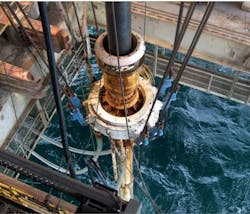UK offshore sector entering period of slow recovery, report finds
Offshore staff
LONDON – UK offshore activity fell sharply last year, according to the Oil and Gas UK (OGUK) 2021 Business Outlook, with overall expenditure down by more than one-quarter compared with 2019.
Prior to the arrival of COVID-19, the predicted capital investment across the sector was £5-5.5 billion ($6.94-7.64 billion), similar to 2019 levels. But the actual figure was £3.7 billion ($5.14 billion), due largely to offshore program deferrals and cancellations.
Despite improved market conditions, capex will likely remain in the range £3.2-3.7 billion ($4.17-4.44 billion) this year, as companies grapple with investor confidence, the need to re-build balance sheets, safely increasing offshore personnel levels, and factoring net zero considerations into new projects.
The report estimates that around £3 billion ($4.17 billion) of previously expected capital investment has been deferred in 2020 and 2021. Last year, the sole new projects approved for development by the Oil & Gas Authority were Sillimanite field on the UK/Dutch median line and IOG’s cluster development of the Blythe, Elgood and Southwark gas fields in the southern North Sea.
However, significant opportunities are under consideration for approval in 2021 and 2022 which collectively could entail over £5 billion ($6.94 billion) of new investment. If these do progress, overall UK investment levels could rise to £4 billion ($5.55 billion) in 2022, then level off at around £3 billion/yr through 2025.
Improved collaboration with the supply chain could also deliver solutions to some of the project challenges, the report suggested.
UK opex last year totalled £6.6 billion ($9.17 billion), down from £7.3 billion ($10.14 billion) in 2019, as companies deferred offshore activities and reduced offshore headcounts by around one-fifth to reduce exposure to COVID-19.
The forecast figure for opex this year and next is £6.5-7 billion ($9.03-9.72 billion).
During 2020 the UK basin still produced just over 587 MMboe, or 1.61 MMboe/d, equivalent to 70% of the UK’s total oil and gas demand. Oil output was 7% lower, but gas only declined by 1%.
This shows the resilience of the sector, the report suggested, given the challenges facing offshore operations in a pandemic. OGUK expects a further 5-7%/yr dip in production during 2021 and 2022, reflecting lower levels of recent brownfield and greenfield programs and the likely impact of increased planned maintenance outages that had to be deferred in 2020, notably of the Forties Pipeline System which handles production from many North Sea fields.
New projects under review for investment approval in 2021 and 2022 could deliver around 700 MMboe, but they remain contingent on market stability and continued regulatory and government support.
UK offshore drilling should recover slightly this year, with potentially 70-80 development wells, 10-12 exploration wells and three to five appraisal wells, similar to activity levels in 2016-18.
Around one-third of UK offshore well decommissioning plans were deferred last year but again, activity should recover in 2021, and will be followed by a further increase in 2022 as companies revisit deferred plans.
At the same time, some companies may look to advance existing plans presently deferred to 2022-23, in order to benefit from the higher commodity prices.
Scott McGinigal, vp Business Services, CNOOC, spoke of the impact of COVID-19 on his company’s UK North Sea activities at a webinar to coincide with the report. “It’s been a challenging year.
“Our business continuity team is constantly trying to improve control measures to allow our staff to work safely offshore. We have reduced POB numbers offshore, implemented testing.
“Now we are looking for additional accommodation to undertake the work that we couldn’t do last year, but also to provide more distancing against COVID-19…
“But we have managed to sustain our drilling operations and progress projects like Buzzard Phase 2 [in the UK central North Sea]. The industry should be proud of its great resilience during this period with UK production only down by 5%. And also the resilience of our workforce…in complying with new control measures, whether getting offshore or working at home - that has been critical.”
The situation has led to improved collaboration with other operators and the supply chain, he continued, although with the oil price higher “it might be more difficult to remain collaborative in that environment. But we are working with the supply chain on efficiency, everyone is coming to the table on how to prioritize things.”
Another focus for CNOOC is the current appraisal drilling on the potentially large Glengorm gas-condensate discovery in the UK central North Sea. “We are looking at what the development might be, the technology needed, the best options, and net-zero considerations are also key to that.
“For UK offshore operators as a whole to meet the UK’s net-zero emissions challenge going forward, “we will need new people and ideas to tackle that,” McGinigal said.
But in order to attract these individuals, the UK offshore industry must also convince them that it has a compelling long-term vision, he cautioned. “Marketing the industry will be a key factor.”
03/16/2021
